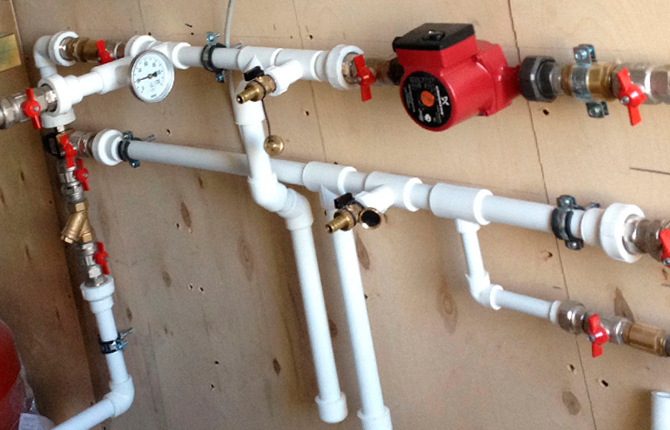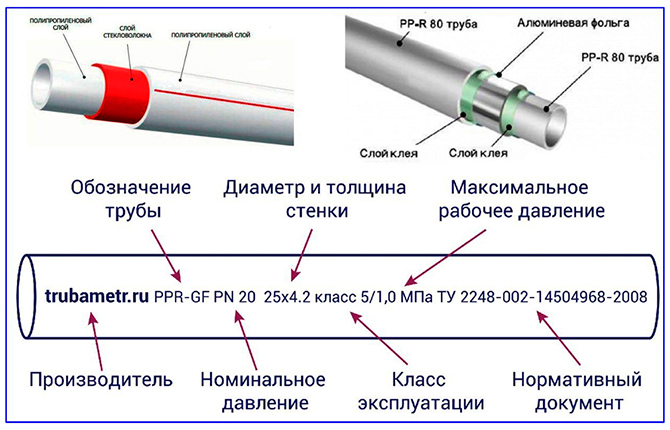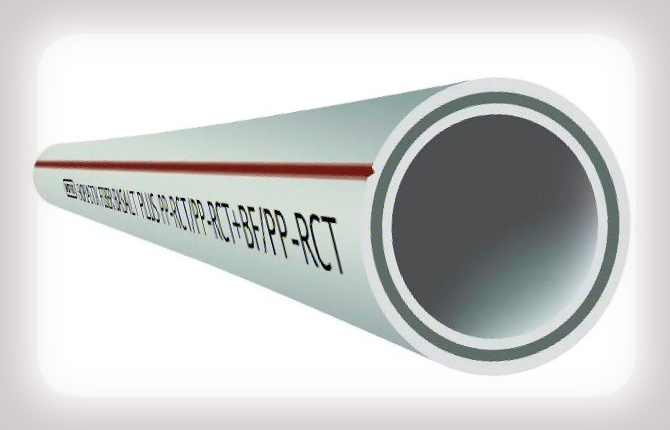Of the variety of polymer pipes for water, products made of polypropylene are especially in demand. The material is easy to process, easy to cut and solder. From the nomenclature of sizes 16-60 mm, a polypropylene pipe 25 mm is more often bought. This is a universal size - suitable for both water and heating.
The content of the article:
-
How it is arranged and where it is applied
- Characteristics of the pipe 25 mm
- We pay attention to the material and scope
- What types are produced
- How to install
How it is arranged and where it is applied
The popularity of 25 mm tubular billets is due to the successful combination of the size of the flow area, the maximum water pressure and the cost of the material. A polypropylene pipe with a transverse dimension of 2.5 cm is easy to hold with one hand when cutting blanks or when welding with couplings or adapters.
Fittings for 25 mm polypropylene pipes are available in large enough to provide a strong brazed seam, but at the same time, the details do not look overall, so they do not spoil the appearance of the plumbing or system heating.
Advantages of using polypropylene pipes with an outer diameter of 25 mm:
- Large capacity for water consumption. It is enough to provide drinking water to a residential building or apartment for 120-150 m2.
- Small diameter. It is easy to hide a 25 mm pipe in a wall under plaster or close it with a decorative box.
- High strength polypropylene pipe with an optimal index value SDR.
Another positive factor is the low coefficient of thermal conductivity.
It is equal to 0.15 W / (m * K). This is about the level of dry cardboard. For comparison, for dry reinforced concrete and steel, it is 1.55 W / (m * K) and 45.4 W / (m * K). The difference is several orders of magnitude. This means that the heating system on 25 mm polypropylene pipes will not lose heat in intermediate sections. All energy is dissipated in the places where radiators or batteries are installed.

This makes the 25 mm tubular stock truly versatile – it can be used for any purpose, so customers purchase material with a small margin.
Before buying a polypropylene pipe, you need to pay attention to its marking. Pipe blanks with a diameter of 25 mm differ in characteristics, internal diameter, wall thickness and maximum water pressure.
In addition, in the marking of pipes, in the price offers of manufacturing companies and distributors, a dimensional characteristic of 25 mm is used. This value refers to the outer diameter of the polypropylene blank, although this is not entirely accurate.
In fact, the size of the workpiece is not 25 mm, but somewhat larger. For example, for a pipe designed for a working pressure of 20 bar, the initial diameter is 26.2 mm. After preliminary preparation before soldering, chamfering and calibration, the polypropylene pipe acquires the required 25 mm.
Characteristics of the pipe 25 mm
General information about polypropylene pipelines is set out in GOST 32415-2013. Pipes with a size of 25 mm are produced under different working pressures. To designate the bearing capacity of blanks in terms of internal pressure, the indices SDR or PN are used. The last to determine the pressure standards. They work both for pipes of 25 mm and for other diameters.
According to GOST, standards are set in:
- 10 bar (PN10);
- 16 bar (PN16);
- 20 bar (PN20);
- 25 bar (PN25).
The SDR indicator characterizes the design of a polypropylene pipe. This is a numerical value obtained by dividing the pipe diameter (25 mm in this case) by the wall thickness.
Billets designed for different pressures will have a different inner diameter (pipe).
| Outer diameter 25 mm | SDR=5 and PN25 | SDR=6 and PN20 | SDR=7.4 and PN16 |
| Wall thickness, mm | 5,1 | 4,2 | 3,5 |
| Inner diameter, mm | 14,8 | 16,6 | 18 |
Workpieces with an outer diameter of 25 mm, but with different PN and flow area, differ in internal volume. This is important and must be taken into account when designing heating systems.
Internal volume of a polypropylene pipe 25 mm:
- for PN16, one linear meter of the workpiece holds 0.254 liters of water;
- for PN20 - 0.237 l of water;
- for PN25 - 0.171 l of water.
Information about the volume will help determine the total capacity of the heating system, make a calculation based on the performance of the pump and boiler.
The PN value indicated in the passport for a polypropylene blank characterizes the maximum pressure at room temperature. For a standard PPR or PPR-C polypropylene pipe, the temperature limit is 70 OC, but at a pressure of 8 bar.
At 60 OWith a blank of 25 mm made of polypropylene PPR100, class PN20, will withstand a maximum of 13 bar. If it is required to ensure the maximum values of pressure and temperature, then it is necessary to use blanks of the "PP-FIBER" "PP-ALUX" class with a reinforcing layer.
We pay attention to the material and scope
Two types of polypropylene are used for plumbing and heating systems:
- Random copolymer. The pipe marking may be PPR, PP-R is the regular version, or PPR-C is the heat stabilized version.
- PPS - polypropylene. Differs in high plasticity and a possibility of operation at negative temperatures up to -20 ℃.
Other brands - PPH, PPB are used for non-pressure systems, including ventilation and drainage, for sewage.
PPR-pipe with an outer diameter of 2.5 cm is mainly used for water supply systems. Wiring is made from it inside a house or apartment, additional branches for outbuildings and auxiliary needs (boiler room).
If you change the old steel plumbing, then the PN20 and SDR6 class polypropylene blank will be equivalent in section to sections with a diameter of ½ ''. Pipe sections of ¾ '' in theory can be replaced with a PPR pipe with SDR10-11, provided that the system will be operated at a temperature of no more than 40 ℃.
You can also use the "25" pipe for heating. For example, for space heating using an individual system based on a gas boiler with a circulation pump. The pressure in the heating circuit does not exceed 1.5-1.7 bar, the outlet temperature is 60-70 ℃. For such conditions, PPR pipes with PN20, SDR6 or PN25, SDR5 can be used.
| Inner diameter 25 mm | Water flow rate in the heating line, m/s | ||||
Heating power W (volume of water per minute) |
0,2 | 0,3 | 0,4 | 0,5 | 0,6 |
7983(343) |
11975(515) |
15967(687) |
19959(858) |
23950(1030) |
In the first case, with optimal values of the coolant flow of 0.3-0.4 m / s, the pump will pump 400-500 l / min of hot water, delivering 10-12 kW / h of heat to the radiators. In the second, the flow rate will decrease to 230-300 l / min, the thermal power, under equal conditions, will drop to 5.5-7 kW / h.
PPR pipe can be used for residential hot water supply. Hot water temperature rarely exceeds 60-70℃, so it is quite possible to use polypropylene pipe stock with PN20 and SDR6. If, according to the conditions of heating or hot water supply, it is required to provide water supply with more high temperature and pressure, then instead of conventional PPR pipes for 25, models with reinforcing sublayer.
The application is not limited to heating and water supply of private households. The main advantage of the 25th PPR pipe lies in the simple soldering technology and the high strength of the joint. Therefore, from the remnants of the material used for the manufacture of water pipes, channels for laying wiring are often made, tubular frames of canopies, greenhouses, and greenhouses are assembled. Some craftsmen are laying water mains for irrigation or collecting rainwater.
What types are produced
For domestic water supply and heating, four types of blanks based on polypropylene are used:
- standard non-reinforced based on random copolymer;
- polypropylene pipe reinforced with fiberglass or glass fiber;
- reinforced with aluminum foil;
- with a reinforcing sublayer based on basalt fiber.
The first three species have long been known on the market. For many years they have been used for the manufacture of plumbing and heating systems. The basalt option has recently appeared on the market for water supply systems.
In all cases, the blank is made on the basis of PPR-polypropylene. The design consists of three layers. External and internal - polypropylene. The internal reinforcing can be made of thin aluminum foil glued to the inner sublayer, or in the form of a composition of polypropylene and mineral fiber, glass or basalt.

The option with a reinforcing aluminum sublayer was considered the best solution for soldering heating systems a couple of years ago. Usually these are PN25 class models with a total wall thickness of 0.42 cm. Relatively reliable and inexpensive. The pipe has only one drawback - the need to clean the outer layer of polypropylene to the foil before soldering.
Glass fiber reinforced blanks with a diameter of 25 usually have a wall thickness of 0.42 cm, designed for a maximum pressure of 20 bar. The inner reinforcing layer contains up to 30% fiberglass. Withstands heat up to 90℃.
Pipes reinforced with basalt fiber differ from glass-filled pipes in three ways:
- polypropylene blanks with basalt are more expensive than glass-fiber ones;
- 30% less wall thickness;
- 20% higher stiffness and tensile strength.
The reliability of the basalt sublayer is higher, less sensitive to thermal shocks and deformations. Models based on basalt fiber reinforcement are rapidly becoming cheaper and replacing aluminum and fiber.

How to install
The most convenient option is to install a polypropylene pipe on clips or clamps. Clip fasteners are convenient for easy installation and low price for fasteners. For example, single clips for good quality 25 mm polypropylene pipes cost between $ 0.01-0.015. a piece.
Clips are mainly used as sliding supports. Due to this, the polypropylene pipe can move inside the support during heating and thermal expansion.
Mounted on the wall with a dowel and a plastic plug. The clip fastening system is such that its position can be adjusted in the direction perpendicular to the axis of the pipeline.
Clamps differ from clips in that the coverage of a polypropylene pipe is performed by one or two metal brackets-arms. Clamp fasteners are more often a stationary, non-slip support. Therefore, they can mount pipes on the wall and even on the ceiling surface. The cost of a clamp for a pipe of 25 mm is not more than 0.5 dollars. a piece.
The number of clips used to fasten polypropylene pipes can be unlimited, regardless of whether it is cold water or a heating circuit. Clamps have limitations. For a section of 6 m, there should be no more than two stationary supports, the rest are made according to a sliding scheme.
In addition to clamps and clips, polypropylene pipes can be laid in the walls of a room or under a concrete screed, but always in a heat-insulating cover. For wall mounting, a strobe is cut out in the masonry, the dimensions of which must be at least twice the diameter. For a pipe of 25 mm, a groove of 50x50 mm is cut.
If polypropylene pipes are poured into concrete, then a thermal expansion compensator must be inserted into the line break, otherwise cracks may form during shrinkage or heating of the pipeline.
Polypropylene pipe 25 mm is considered the most versatile of all possible sizes. Its throughput is enough to connect a whole branch of heating from 7-8 radiators. A standard flow rate of 250-300 l/m will provide reliable water supply for two or three families at the same time.
Polypropylene pipes: types, fittings, components. Master class on soldering pipes: video.
Tell us about your experience in choosing the right diameter in the comments - why was this size preferred and by what criteria? Bookmark the article so that useful information is always available.


